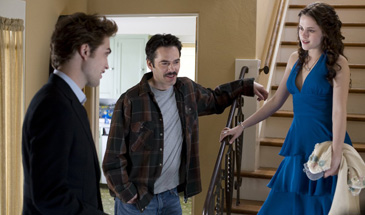|
|
Book vs. Movie: TwilightBy Russ BickerstaffNovember 24, 2008
The Book The first novel by Mormon housewife Stephenie Meyer, Twilight was inspired by a dream she had of a woman and a vampire on June 2, 2003. She wrote the dream down and, in spite of very little previous writing experience, promptly turned it into a rather lengthy novel. The novel tells the story of a high school girl named Bella Swan, who is prompted to move away from her native Phoenix, Arizona to live with her father - the chief of police for the tiny town of Forks, Washington. The very earliest portions of the novel read like traditional juvenile fiction about a new girl in town who has moved from a big, populous, bright and sunny place to a small, rural town perpetually shrouded in rain. This part of the novel carries itself quite well as Meyer's literary voice is not unwelcoming, emanating as it does from Bella's first person perspective. One can tell that Meyer has a love for the language even if everything present here is lacking in the kind of conversational poetry present in the work of a more inspired, more accomplished author. The novel shifts gears as Bella becomes attracted to Edward Cullen - an eerily beautiful kid in her school who seems to be just a bit more independent and sophisticated than the rest of the students at Forks High School. Her interest in Edward increases as he saves her from certain death in the high school parking lot. It's a long and nuanced romance that builds between Edward and Bella as she slowly comes to understand that he is a 100-year-old vampire who belongs to a family of socially altruistic bloodsuckers who refuse to feast on humans, preferring the blood of wild animals. In Meyer's world, the bright light of direct sunlight doesn't destroy a vampire - it merely makes their skin radiant, thus giving them away as being other than human. It is for this reason that Edward's group of vampires lives in one of the cloudiest places in North America.
[ View other Book vs. Movie columns ]
[ View other columns by Russ Bickerstaff ]
[ Email this column ]
|

|
|
|

|
Friday, November 1, 2024
© 2024 Box Office Prophets, a division of One Of Us, Inc.


